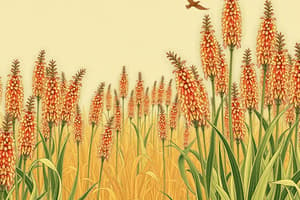Podcast
Questions and Answers
What is the origin of Sorghum?
What is the origin of Sorghum?
- East Central Africa (correct)
- South East Asia
- North America
- Western Europe
Which variety of Sorghum is known for drought and salinity tolerance?
Which variety of Sorghum is known for drought and salinity tolerance?
- CSH-1 (correct)
- Combine Kafir-60
- Sorghum bicolor
- M 35-1
What is the chromosome number of Sorghum?
What is the chromosome number of Sorghum?
- 2n=40, n=20
- 2n=30, n=15
- 2n=20, n=10 (correct)
- 2n=25, n=12
At what stage should Sorghum leaves NOT be used for fodder?
At what stage should Sorghum leaves NOT be used for fodder?
What type of plant is Sorghum classified as?
What type of plant is Sorghum classified as?
What is the optimum temperature range for growing Sorghum?
What is the optimum temperature range for growing Sorghum?
What is the pH range in which Sorghum thrives?
What is the pH range in which Sorghum thrives?
What is Sorghum sickness related to?
What is Sorghum sickness related to?
Which medicinal plant is known for its antibiotic and antitumor activities found highest in its leaves?
Which medicinal plant is known for its antibiotic and antitumor activities found highest in its leaves?
What is the chief medicinal compound present in the roots of Safed Musli?
What is the chief medicinal compound present in the roots of Safed Musli?
Which plant is primarily used to treat arthritis and heart problems?
Which plant is primarily used to treat arthritis and heart problems?
What is the primary economic part of the Indian Ginseng plant?
What is the primary economic part of the Indian Ginseng plant?
Which of the following plants is propagated by seeds?
Which of the following plants is propagated by seeds?
Which plant is used as a biogenic stimulator and wound healing hormone?
Which plant is used as a biogenic stimulator and wound healing hormone?
What is the optimum depth for sowing sorghum seeds?
What is the optimum depth for sowing sorghum seeds?
What is the recommended seed rate for fodder purpose sorghum cultivation per hectare?
What is the recommended seed rate for fodder purpose sorghum cultivation per hectare?
Which pathogen causes Downy Mildew in sorghum?
Which pathogen causes Downy Mildew in sorghum?
What is the appropriate amount of nitrogen fertilizer to be applied per hectare in sorghum cultivation?
What is the appropriate amount of nitrogen fertilizer to be applied per hectare in sorghum cultivation?
Which of the following insects is a major pest in sorghum cultivation?
Which of the following insects is a major pest in sorghum cultivation?
What is the ideal moisture content in sorghum grains at the time of harvesting?
What is the ideal moisture content in sorghum grains at the time of harvesting?
How many plants per hectare is the approximate plant population for sorghum?
How many plants per hectare is the approximate plant population for sorghum?
What is the yield of hybrid sorghum (Grain) per hectare?
What is the yield of hybrid sorghum (Grain) per hectare?
Flashcards
Sorghum's Scientific Name
Sorghum's Scientific Name
Commonly known as Sorghum or Jowar, its scientific name is Sorghum bicolor.
Sorghum's Origin
Sorghum's Origin
Belongs to the Gramineae family and originated in East Central Africa.
"Camel Crop"
"Camel Crop"
Known as the 'Camel crop', it is highly drought-tolerant.
Sorghum Chromosome Number
Sorghum Chromosome Number
Signup and view all the flashcards
Sorghum Amino Acids
Sorghum Amino Acids
Signup and view all the flashcards
Hydrocyanic Acid (HCN) in Sorghum
Hydrocyanic Acid (HCN) in Sorghum
Signup and view all the flashcards
Sorghum Temperature Range
Sorghum Temperature Range
Signup and view all the flashcards
Sorghum Water Requirements
Sorghum Water Requirements
Signup and view all the flashcards
Sorghum Soil Preference
Sorghum Soil Preference
Signup and view all the flashcards
Ideal Soil Type for Sorghum
Ideal Soil Type for Sorghum
Signup and view all the flashcards
Sorghum Seed Rate
Sorghum Seed Rate
Signup and view all the flashcards
Sorghum Sowing Depth
Sorghum Sowing Depth
Signup and view all the flashcards
Sorghum Planting Time
Sorghum Planting Time
Signup and view all the flashcards
Farmyard Manure (FYM)
Farmyard Manure (FYM)
Signup and view all the flashcards
Fertilizer Requirements for Sorghum
Fertilizer Requirements for Sorghum
Signup and view all the flashcards
Downy Mildew Scientific Name
Downy Mildew Scientific Name
Signup and view all the flashcards
Shoot Fly Scientific Name
Shoot Fly Scientific Name
Signup and view all the flashcards
Best Harvesting Time
Best Harvesting Time
Signup and view all the flashcards
Aloe Vera
Aloe Vera
Signup and view all the flashcards
Indian Ginseng
Indian Ginseng
Signup and view all the flashcards
Foxgloves
Foxgloves
Signup and view all the flashcards
Study Notes
Sorghum Overview
- Commonly known as Sorghum or Jowar, scientifically identified as Sorghum bicolor.
- Belongs to the Gramineae family, with origins tracing back to East Central Africa.
- Known as the "Camel crop" due to exceptional drought tolerance.
- Chromosome configuration is 2n=20, n=10.
- Sorghum exhibits hypogeal germination and is primarily cross-pollinated.
Nutritional Information
- Sorghum grains are low in Lysine but high in Leucine, making them a valuable source of energy.
- Contains Hydrocyanic acid (HCN) in leaves, which is toxic to livestock if consumed before 50% flowering.
Cultivation and Climate Requirements
- Thrives in warm climates with a temperature range of 8-10°C (minimum) to 32-35°C (optimum), and can withstand up to 38°C (maximum).
- Requires a total water input of around 350 mm throughout its growth.
- Prefers clay loam or loam textures and tolerates pH levels from 6.0 to 8.5.
Soil Management
- Black cotton soil of central India is particularly suitable for sorghum cultivation.
- Sorghum residues can lead to nitrogen immobilization in soil due to a high C:N ratio, potentially requiring additional nitrogen for succeeding crops.
Seed Rate, Spacing & Sowing
- Recommended seed rate ranges from 12-15 kg/ha for normal conditions and up to 30-35 kg/ha for hybrid varieties.
- Sowing depth should be maintained at 3-4 cm with a plant spacing of 45x12 cm.
- Ideal planting time is from late June to early July.
Fertilization
- Requires 10-15 tonnes of farmyard manure (FYM) per hectare.
- Fertilizer recommendations include nitrogen: 100 kg/ha, phosphorus: 50 kg/ha, potassium: 40 kg/ha.
Diseases and Pests
- Major diseases include Downy Mildew (Peronosclerospora sorghi), Anthracnose (Colletotrichum graminicolum), and Grain Smut (Sphacelotheca sorghi).
- Key insect pests are Shoot Fly (Atherigona varia soccata), Sorghum Midge (Contarinia sorghicola), and Shoot Bug (Peregrinus maidis).
Harvesting and Yield
- Best harvesting time is when grains are hard and moisture content is below 25%.
- Average yields are 25-30 q/ha under rainfed conditions, 300-400 q/ha for fodder, and 40-50 quintals per hectare for hybrid grain varieties.
Medicinal Plants Overview
- Aloe Vera: Perennial succulent in the Liliaceae family, known for its healing properties and contains the compound Glucomannan.
- Indian Ginseng: Adaptogenic herb from the Solanaceae family, roots are utilized for multiple health benefits, rich in withanine and somniferine.
- King of Bitters: Herbaceous plant from the Acanthaceae family, its leaves and roots are used in traditional medicine for treating snake bites and jaundice, rich in andrographolide.
- Safed Musli: Also belongs to the Liliaceae family, used as an aphrodisiac and for its saponin content.
- Guggal/Indian Bdellium Tree: Originating from Africa and Asia, its gum resin treats various health issues like arthritis and heart problems.
- Medicinal Yam: Tubers from the Dioscoreaceae family known for their economic significance.
- Foxgloves: Leaves of this Scrophularaceae family member are utilized for heart diseases, containing digoxin, propagated by seeds.
Studying That Suits You
Use AI to generate personalized quizzes and flashcards to suit your learning preferences.



